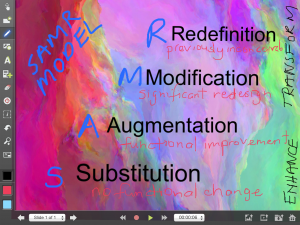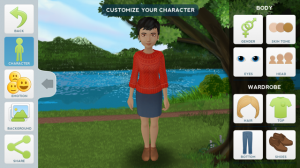Everyone is talking about the SAMR model for eLearning.
A principal emailed me this week wanting to know more about the concept so I emailed her with a reply but thought it may be useful to add my thoughts more publicly too.
The SAMR model is based on the thinkings of Ruben Puentedura.
In a nutshell here is how I see what the SAMR letters stand for.
S– Substitution– would be you just used an iPad as a flash sort of text book for the kids to read and copy from.
A– Augmentation– you might have the text book read to you via Speech Selection so that is moving things up a notch.
M– Modification– You might make your own book using Book Creator that includes graphics, audio, video and hyperlinks etc
R– Redefinition– You might have students all collaborating making pages for a Book Creator including graphics, audio, video and hyperlinks etc and combining them in one book which you then publish it on iTunes.
I made this graphic using Explain Everything app to show the levels of SAMR.
I think that the iPad can be an excellent vehicle to raise our game around learning but I am concerned that some teachers think that if they had enough iPads, or Chromebooks, or laptops or whatever, then they would be better teachers and the children better learners. Unfortunately it doesn’t happen like that.
I have seen some people place different iPad apps on a dimension of the SAMR model as though there they sit, fixed, but I would beg to differ.
Take for example the free app Tellagami for iPad, iPod Touch and iPhone. At its most basic level it is an avatar maker- you can change the look and features of a male or female avatar and take a screen grab! Easy enough but let’s put it on the SAMR model.
S– Substitution– You make an avatar, take a screen grab to use as a prompt for writing in writing time.
A– Augmentation- You could create an avatar, upload a background image then write or record a script for it to describe a classroom happening, a visual mihi, or whatever as in this intro I made for an upcoming iPad workshop. Or a learner could take a photo of their artwork and their avatar could talk about how it was made and a self reflection on the process.
Launching Learning with an iPad from Allanah King on Vimeo.
M– Modification– You could combine the learners’ short projects into one segmented movie using iMovie. This example by Greg Swanson, ADE from Australia, shows this idea really well. His students each produced a segment for the instructional video to show evidence of learning.
R– Redefinition– You might invite others, not from your school, or region or country to each make their own segment, then collaborate to make and share their Tellagami projects. The end result being a collaborative video like Paul Hamilton, another Australian ADE has done with this project.
So what I am saying here is try to think of and use apps that allow learners to create, engage,connect and collaborate. Aim for the Redefinition end of the SAMR model- don’t limit yourself to the mere Substitution dimension.
I would love to hear your thoughts and examples and thoughts on using the SAMR model in your classroom with your students.



I agree with you on two fronts.
1. Aim for the higher levels in the SAMR model
2. Rather than focus on where an app fits in relation to SAMR’s 4 levels, focus instead on what you want students to be able to do
Your post applies equally well to secondary schools too. Thanks for sharing your thoughts!
Thanks for this really clear explanation of the SAMR model. All too often the substitution part is what most people stop at especially when they first start using technology of any kind. Getting further along really needs us to think about the why and not the how first. It all comes back to putting pedagogy first and also thinking about developing higher order thinking skills in our students. Definitely food for thought.
I like the way you have described how 1 app can be used through all stages – neat to see the actual examples as well. This makes it very clear for teachers. Thanks
SAMR is such a useful model to help explain what transforming learning means.
Found this cool little interactive SAMR graphic http://www.educatorstechnology.com/2013/07/samr-ladder-wonderful-graphic-for.html
Thanks for the SAMR briefing!
Like I always say ipads/laptops etc are just tools – having a bunch of them doesn’t make us better classroom teachers any more than having a piano in our rooms would make all of us better music teachers – it’s always the pedagogy and PD behind the technology that make it significant.
A great, succinct explanation with useful examples. I appreciate that you haven’t disparaged the Substitution level, as I have seen in other posts. It is important to realise that there is nothing wrong with using technology as a substitute for good things you have done in the past.
I see the SAMR model as a challenge to put before teachers. The vast majority of teachers do want to do a better job of teaching. Those who don’t want to, shouldn’t be teaching, which is a different matter altogether. By providing teachers with a simple model that says “this is what it means to do it better”, they have some scaffolding by which to guide their planning.
Thanks, Allanah!
I should have added- here are my other SAMR resources that I have curated.
https://www.diigo.com/user/allanahk/SAMR
Deon,
Thanks for your feedback- re disparaging the Substitution dimension. I think people need to become familiar with an app by using it first.
In doing this they can maybe see the possibilities and potential of using the tool.
The problem is if people can’t see the possibilities or are happy just that the learners are using tech.
Thanks for sharing your resources. I have a few others you may or may not have seen as well as some questions designed to get participants thinking more thoughtfully about SAMR here,
Thanks for sharing your resources. I have a few others you may or may not have seen as well as some questions designed to get participants thinking more thoughtfully about SAMR here,
http://balancedtech.wikispaces.com/SAMR
I have just read your posting on the SAMR model and it fits perfectly with a discussion I had with my Y2 class about a week ago.We use the apps on our 3 classroom ipads for a variety of learning activities.They listen to stories, practise spelling and phonics, play maths games and write with Pages. When asked what their favourite apps were they all agreed they prefer using apps such as Tellagami, Popplet, Pic Collage, Fotobabble, Audio Boo, Word Collage, Sock Puppets and Puppet Pals etc. When asked why, their reasons were they enjoy the creativity with a peer,exploring new ideas and presentations and recording their reflections. Most of all they like the opportunities these apps give them to share their learning by embedding in their class blog. They might only be 6 and 7 years old, but I am proud of the way they think.
Thanks Cheryl
Great to hear that you, and your class, are on the right track. WE have to give kids credit for knowing what is good!
I still can’t get Fotobabble to work right for me- otherwise I would be promoting it more!!
Thanks Allanah,
I love Tellagami, and love watching your site and all of the fabulous things you post.
My name is Sarah Barnett and I am a student at the University of South Alabama. I am taking a class called EDM 310. I have been assigned to comment on your blog and then create a summary of the blogs I have read. I really enjoyed this post. I have never heard of the SAMR model, but after reading your post; I know about SAMR model now. Your explanation is creative and interesting! I can’t wait to try the app Tellagami on one of my own assignments. It seems like a fun program. Thank you for sharing! Hope you have a great week!
Thanks for clearly explaining the SAMR process. Tellagami can be a great tool to use for students as well as teachers. My school used Tellagami to create an Augmented Reality Scavenger Hunt for students. There seems to be a lot of classroom potential with that particular app.
Thanks for showing me useful information on your blog.
Brand Animators – Bringing Your Vision to Life with Innovative Video Solutions. From start-ups to large corporations, every business has a unique story to tell. At Brand Animators, our mission is to help you tell that story in a captivating and memorable way. As a top quality 3d, 2d animation video production company in Houston, Texas and best explainer video company in San Antonio, Texas and professional Healthcare & Medical animation video making studio in Dallas, Texas offer services such as 2d animation videos 3d animation videos, Motion graphics, 3d medical animation, Healthcare videos, Corporate films, Whiteboard animation videos, 3d Architectural walkthrough animation, Marketing and training videos, Product videos. And more! Whether you’re looking to promote your brand, educate your audience, or simply convey information in an engaging and visually appealing manner, Brand Animators has you covered. Our video solutions are tailored to your budget, timeline, and company objectives.